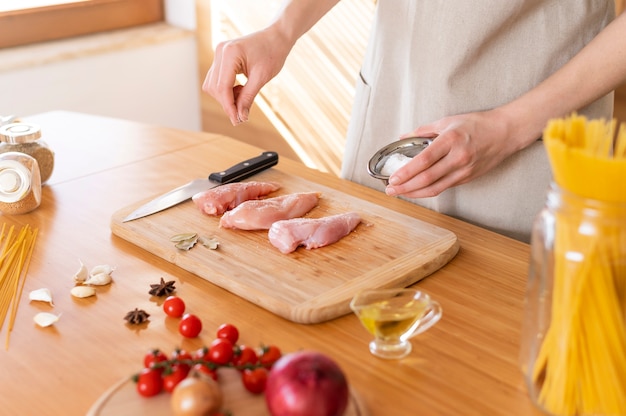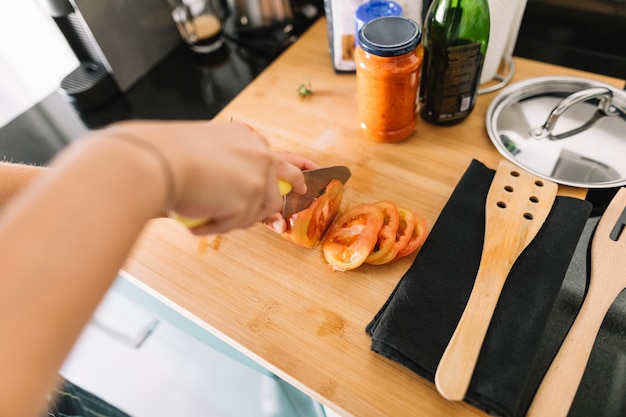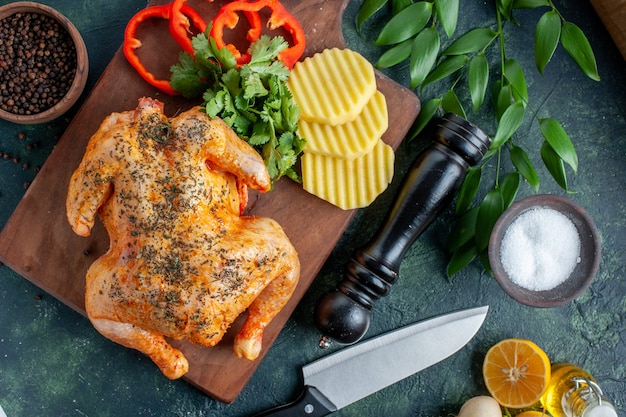I'll be honest, the moment I smell that golden, crispy crust of a perfectly-cooked chicken fried steak, I'm transported back to childhood dinners at my grandparents' house. It’s a dish that embodies the very essence of southern comfort food – hearty, flavorful, and guaranteed to bring smiles around the table. But let's face it, achieving that perfect balance between crispy, crunchy exterior and juicy, tender interior isn't as simple as it seems. It's a culinary dance, and one that requires a bit of finesse (and maybe a sprinkle of patience).
So, if you're ready to embark on your own chicken fried steak culinary adventure, buckle up! This guide will walk you through every step, from selecting the ideal cut of meat to mastering the art of breading and frying, culminating in a symphony of flavors that'll have your taste buds singing.
(Part 1) The Cut of Meat: The Foundation of a Good Chicken Fried Steak

Imagine a well-built house - you can't have a magnificent structure without a strong foundation, right? The same applies to a good chicken fried steak – it all starts with the right cut of meat. You want something that's tender enough to cook through without turning into shoe leather, but also sturdy enough to hold its shape during the breading and frying process.
The Classic Choice: A cube steak
Think of cube steak as the classic, reliable choice for chicken fried steak. These thin, flattened cuts of meat are the epitome of "ready to go." They cook quickly and evenly, ensuring a tender bite. And let's not forget, they get their name from the process of tenderizing – a mechanical meat tenderizer creates those tiny cubes within the meat, making it more tender and allowing the breading to adhere better. It’s a win-win!
Other Options: Explore Beyond the Classic
While cube steaks are the go-to, don’t be afraid to get creative and explore other cuts of meat. I've had fantastic success with thin-cut sirloin and top round – both offer a great balance of flavor and tenderness. Even boneless pork chops can be a delicious alternative if you're looking for something a little different. Just make sure you pound them flat with a meat mallet to ensure even cooking and prevent those pesky tough spots.
(Part 2) Mastering the Art of Breading

The breading is the heart and soul of a chicken fried steak, the secret ingredient that transforms a simple piece of meat into a culinary masterpiece. It's the key to that glorious golden-brown, crispy exterior, and it takes a little practice to get just right. But trust me, it's worth the effort!
Building the Foundation: A Flour-Based Breading
The traditional breading for chicken fried steak is a simple flour-based mixture. Usually, it’s a combination of flour, salt, and pepper, but you can add a sprinkle of other spices like garlic powder, paprika, or even a pinch of cayenne pepper for a touch of heat. This flour base acts as a binder, ensuring the breading sticks to the meat like glue.
Adding Texture: The Role of Eggs and Milk
To get that satisfying crunch, you need to add a little extra oomph to the breading. That’s where the eggs and milk come in. The egg wash serves as a magical bonding agent, helping the flour mixture adhere tightly to the meat. The milk adds moisture, which creates a lighter, airier breading that's less dense and greasy.
Going the Extra Mile: The Power of Pancetta
Now, for those who really want to elevate their chicken fried steak game, there's a secret ingredient that I've discovered – pancetta! Crumble it up and mix it into your flour mixture, and you'll be surprised by the smoky, salty deliciousness that infuses your breading. It adds a whole new level of flavor, taking your chicken fried steak from good to phenomenal.
(Part 3) Frying: The Key to Crispy Perfection

Finally, we’ve reached the moment of truth – the frying stage. This is where your carefully prepped chicken fried steak transforms from mere ingredients into a culinary masterpiece.
The Oil: A Choice Worth Making
Choosing the right oil is like choosing the right paintbrush for your masterpiece – it sets the tone for the final result. I stick with vegetable oil or canola oil because they have high smoke points, allowing me to cook at a higher temperature without burning the breading.
The Temperature: Don't Rush the Process
One common mistake is rushing the frying process by using oil that's too cold. The breading won't get that irresistible crispy texture, and you'll end up with a soggy mess. Aim for a temperature of around 350°F (175°C). The oil should be hot enough to sizzle when you add the steak, but not so hot that it burns the breading.
Patience is Key: Allow the Steak to Cook Thoroughly
After you've carefully placed your bread-coated steak into the hot oil, resist the urge to flip it too soon. Let it cook for a few minutes on each side until it's golden brown and crispy. Then, gently flip it over and continue cooking until it's cooked through.
Resting is Important: Letting the Steak Recoup
Once your chicken fried steak has achieved that beautiful golden hue, resist the temptation to dive in immediately. Let it rest for a few minutes on a wire rack to allow the breading to crisp up further and the meat to reabsorb some of its juices.
(Part 4) The All-Important Gravy
Chicken fried steak isn't complete without a generous serving of gravy. It's the perfect way to bring all the flavors together and create a truly satisfying meal.
From Scratch: The Ultimate Gravy
For the ultimate gravy experience, there's nothing quite like making it from scratch. It's not as daunting as you might think, and the results are well worth the effort.
- Start by making a roux – a mixture of butter and flour. Cook it until it's golden brown and fragrant.
- Slowly whisk in your choice of liquid, such as chicken broth, beef broth, or even milk.
- Season to taste with salt, pepper, and any other spices that tickle your fancy.
- Continue cooking until the gravy thickens and reaches your desired consistency. You want it thick enough to coat the back of a spoon.
Quick and Easy: A Store-Bought Alternative
Life gets busy, and sometimes you just need a shortcut. Don’t be ashamed to use a store-bought gravy if that's what works best for you. Just choose one that's made with real ingredients and has a flavor that you enjoy.
(Part 5) Accompaniments: Complements to the Star
Chicken fried steak is a dish that begs for some tasty accompaniments to round out the meal and add a touch of variety.
The Classic Choice: mashed potatoes
Mashed potatoes are the classic accompaniment for chicken fried steak. They’re creamy, comforting, and soak up the gravy perfectly. I like to add a knob of butter and a splash of milk for extra richness.
A Southern Twist: Creamy Grits
If you’re feeling adventurous and want a taste of Southern comfort food, try serving your chicken fried steak with creamy grits. They’re a Southern staple and pair beautifully with the rich flavor of the steak.
A Light and Fresh Option: Steamed green beans
For a lighter and more refreshing option, try steamed green beans. They’re a great way to add some color and nutrients to your meal, providing a nice contrast to the richness of the chicken fried steak.
(Part 6) Putting it All Together: A Step-by-Step Guide
Now that we’ve covered all the essentials, let's put it all together into a step-by-step guide to making the perfect chicken fried steak.
Step 1: Preparing the Steak
- Choose your desired cut of meat – cube steak, sirloin, top round, or even a boneless pork chop, if you’re feeling adventurous.
- Pound the meat to an even thickness using a meat mallet. You want it to be about ?? inch thick.
- Season the steak generously with salt and pepper. Don’t be shy!
Step 2: Creating the Breading
- In a shallow dish, combine flour, salt, and pepper. For extra flavor, consider adding a pinch of garlic powder, paprika, or cayenne pepper.
- In another shallow dish, whisk together eggs and milk.
- Dredge the steak in the flour mixture, ensuring it’s completely coated.
- Dip the steak in the egg wash, making sure it’s evenly coated.
- Coat the steak completely in the flour mixture again, making sure all sides are well-covered.
Step 3: Frying the Steak
- Heat oil in a large skillet over medium-high heat. The oil should be hot enough to sizzle when you add the steak.
- Carefully add the steak to the hot oil, ensuring not to overcrowd the skillet.
- Cook for 3-4 minutes per side, or until golden brown and crispy.
- Remove the steak from the skillet and place it on a wire rack to drain excess oil.
Step 4: Making the Gravy
- Melt butter in a saucepan over medium heat.
- Whisk in flour until smooth, creating a roux. Cook it until it’s golden brown and fragrant.
- Slowly whisk in your choice of liquid (broth, milk, etc.).
- Season with salt, pepper, and any other desired spices.
- Continue cooking, whisking frequently, until the gravy thickens.
Step 5: Serving the Steak
- Serve the chicken fried steak immediately with your choice of accompaniments.
- Pour gravy over the steak, letting it pool around those crispy edges.
- Enjoy!
(Part 7) Variations: Beyond the Traditional
Once you’ve mastered the basic chicken fried steak recipe, the possibilities are endless! Get creative and experiment with different variations to suit your taste.
Spicy Kick: Adding a Touch of Heat
For those who love a little kick, add a pinch of cayenne pepper or chili powder to the breading mixture for a touch of heat. You can also make a spicy gravy using hot sauce or jalapeno peppers.
cheesy goodness: Incorporating Cheese
Cheese and chicken fried steak are a match made in heaven! Add some shredded cheddar or mozzarella to the breading mixture for a cheesy surprise, or make a creamy cheese gravy for an extra decadent touch.
Herby Delight: Fresh Herbs for a Unique Flavour
For a more sophisticated twist, incorporate fresh herbs into your breading or gravy. Thyme, rosemary, and sage are all excellent choices, adding a fragrant aroma and depth of flavor.
(Part 8) Tips and Tricks: From a Chicken Fried steak enthusiast
Over the years, I've learned a few tips and tricks that have helped me consistently create those perfect chicken fried steaks. Here are a few of my favorites:
Don't Overcrowd the Skillet: Ensure Even Cooking
When frying your chicken fried steaks, avoid overcrowding the skillet. This will cause the oil temperature to drop, preventing the breading from getting crispy. Fry the steaks in batches if necessary, ensuring each one gets the attention it deserves.
Use a meat thermometer: Ensure Proper Doneness
To ensure your steak is cooked to perfection, use a meat thermometer. It should reach an internal temperature of 145°F (63°C) for medium-rare or 160°F (71°C) for medium.
Keep the Breadcrumbs Dry: Maintaining a Crispy Crust
Keep the breadcrumbs dry when breading the steak. If they get too moist, they won’t stick to the meat as well, resulting in a less-than-ideal crispy texture.
Serve Hot: A Culinary Essential
Serve the chicken fried steak hot to ensure it stays crispy. The breading will soften as it cools.
Leftovers: A Delicious Second Meal
If you have leftover chicken fried steak, it’s just as delicious the next day. Reheat it in a skillet with a little bit of oil until it’s crispy.
(Part 9) Chicken Fried Steak: A culinary journey Through Time
Chicken fried steak has a fascinating history, tracing back to the Southern United States, where it was a popular meal among ranchers and cowboys. They called it “chicken-fried beefsteak” back then, and it was made with a simple flour-based breading and a thin cut of beef.
Over time, chicken fried steak has become a cherished dish across the United States, and countless variations on the classic recipe have emerged. It's often served with gravy, mashed potatoes, and green beans, making a delightful meal that’s perfect for family gatherings and celebrations.
Today, chicken fried steak remains a popular dish, capturing the hearts of many food lovers. It’s a comfort food that evokes nostalgic memories of childhood and family meals, a dish that always brings warmth and satisfaction.
(Part 10) FAQs: Addressing Common Questions
Here are some common questions about chicken fried steak, along with their answers:
1. Is chicken fried steak actually fried chicken?
No, chicken fried steak is not fried chicken. It's a beef steak (or sometimes pork chop) that's been coated in breading and then fried. The name comes from the way the breading resembles the crispy coating of fried chicken.
2. What’s the best way to tenderize a steak for chicken fried steak?
The best way to tenderize a steak for chicken fried steak is to use a meat mallet. Pound the steak to an even thickness, being careful not to over-tenderize it.
3. What’s the best type of oil for frying chicken fried steak?
Vegetable oil and canola oil are good choices for frying chicken fried steak. They have high smoke points, which means they can be heated to high temperatures without burning.
4. What are some good accompaniments for chicken fried steak?
Classic accompaniments for chicken fried steak include mashed potatoes, gravy, green beans, and corn. You can also get creative and serve it with other side dishes that you enjoy.
5. Can I make chicken fried steak ahead of time?
Yes, you can make chicken fried steak ahead of time. Breaded steaks can be refrigerated for up to 24 hours. To reheat, fry them in a skillet with a little bit of oil until they are crispy.
(Part 11) Final Thoughts: A culinary legacy
Chicken fried steak is more than just a dish – it’s a culinary legacy. It's a reminder of the simple pleasures of home-cooked meals, and it’s a dish that has the power to bring people together. So, the next time you’re craving comfort food, give chicken fried steak a try. It’s a dish that’s sure to please, and it’s a culinary adventure that you won’t soon forget.
Everyone is watching

Prime Rib Roast Cooking Time Chart: Per Pound Guide
Cooking TipsPrime rib roast. Just the name conjures images of lavish dinners, crackling fires, and hearty laughter. It’s ...

How Long to Bake Potatoes in the Oven (Perfect Every Time)
Cooking TipsBaked potatoes are a staple in my kitchen. They're incredibly versatile, delicious, and surprisingly easy to m...

Perfect Rice Every Time: The Ultimate Guide to Cooking Rice
Cooking TipsAs a self-proclaimed foodie, I've always been a bit obsessed with rice. It's the foundation of countless cuisi...

The Ultimate Guide to Cooking Asparagus: Tips, Techniques, and Recipes
Cooking TipsAsparagus. The mere mention of this spring delicacy conjures up images of vibrant green spears, crisp and burs...

Ultimate Guide to Cooking the Perfect Thanksgiving Turkey
Cooking TipsThanksgiving. Just the word conjures up images of overflowing tables laden with delicious food, the scent of r...
